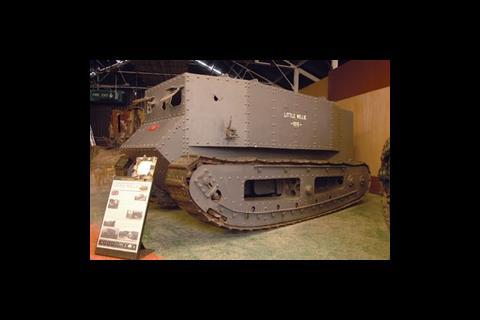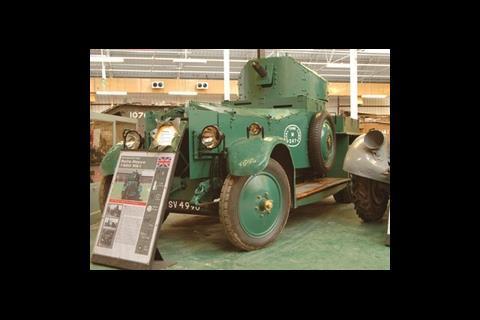Doug King explains how a team of environmental engineers and exhibition staff came up with a cost-effective design to conserve and display an international collection of tanks in Dorset
The Tank Museum at Bovington in Dorset was established after the First World War when, on a visit to the Army camp, Rudyard Kipling noticed several tanks that had returned from battle being allowed to rust in a local field. A collection of some of the more significant examples was fenced off and the museum begun.
Today the museum holds the national collection of armoured fighting vehicles, with examples of nearly every tank ever used by the British Army and many from overseas. The collection includes examples ranging from Little Willie – the first tank ever built – and the priceless Rolls Royce Armoured Car, often seen at national events, through to the Challenger 1 tank used in the first Gulf War and the latest Challenger 2.
The museum currently comprises 8500 m2 of buildings in various states of disrepair. The historic vehicles are housed in buildings with environmental control ranging from heated-with-ventilation through to simple untreated enclosures which protect the vehicles from the worst of the weather. With insufficient enclosed space, some vehicles are simply kept out in the open, protected only by tarpaulins.
In 2002, the museum trustees began developing a masterplan for redevelopment to bring the museum buildings up to scratch and provide an enhanced visitor experience. The cornerstone of this plan is the construction of a new 4500 m2 display hall specifically tailored to the needs of historic tanks.
As with many museum projects, it was initially assumed that close-control air-conditioning would be required for the conservation of the objects. However, providing this resource would be a highly costly proposition, due to the enormous space required to house the entire collection.
An alternative solution
At the early feasibility stage, King Shaw Associates, which provided the environmental engineering, worked with the curator to review and catalogue the collection of vehicles and other artefacts, their condition and current storage. We then considered the decay processes involved and discovered that the desire to finely control temperature and humidity was chiefly geared to preventing mould growth on canvas and leather harnesses or in the electronics, controls and sighting instruments found within the tanks.
On further examination, we found that many of the original leather and canvas fittings had already been removed for conservation and replaced with facsimiles, leaving just the electronics and instruments to consider. It was then that we hit upon the simple expedient of using desiccant gel for dehumidification within the tanks’ hulls to conserve the interiors – as, with hatches closed, this is a sealed environment. Apart from corrosion, the exteriors are largely resistant to decay.
The most damaging corrosion is caused by electrolytic reactions between dissimilar metals, where brass or aluminium fittings are attached to the steel tank hulls. This requires the presence of liquid water as an electrolyte. Given the potential for corrosion damage, we were concerned that the most ready source of water in the exhibition areas would be from moisture in the visitors’ breath. At peak times, the museum receives over 1000 visitors per hour. Working with the exhibition designers, we determined that the likely average dwell time in the new display hall would be about 40 minutes for each visitor. This would give equivalent peak occupancy of 670 people, together breathing up to 60 litres of moisture per hour onto the tanks.
We therefore established an environmental control strategy which is specifically aimed at preventing condensation on the metal surfaces. Overhead radiant heating panels are designed both to provide energy-efficient comfort heating for the visitors and to raise the surface temperature of the tank hulls above dewpoint, ensuring that condensation does not occur. The thermal mass of the tank hulls themselves then helps to regulate their environment.
Displacement ventilation in the space carries away the moisture introduced by the visitors as quickly as possible, with fresh air delivered via a network of concrete sewer pipes beneath the main display hall floor. In summer, the air will also benefit from ground-coupled passive cooling. The design of the ducts and grilles had to be carefully co-ordinated with the structure of the slab to ensure that it could carry the imposed load of 60 tonne tanks.
The client and design team worked together to develop a strategy to place the most important vehicles, requiring most protection, into the new display hall. This would then liberate space in the existing display halls so that tanks could be brought in from the external storage sheds and in turn, the entire collection would take a step up the environmental control chain.
The Bovington Tank Museum is a Heritage Lottery funded project and is currently in detailed design stage. Construction is due to start in January 2007.
Downloads
Plan for the new display hall at Bovington Tank Museum (PDF)
Other, Size 0 kb
Source
ºÃÉ«ÏÈÉúTV Sustainable Design
Postscript
Original print headline: "Bovington's defence strategy" (ºÃÉ«ÏÈÉúTV Services Journal, July 2006)
























No comments yet